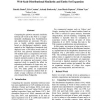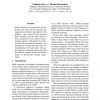93
Voted
COLING
2010
14 years 7 months ago
2010
We present a simple algorithm for clustering semantic patterns based on distributional similarity and use cluster memberships to guide semi-supervised pattern discovery. We apply ...
73
Voted
COLING
2010
14 years 7 months ago
2010
Main approaches to corpus-based semantic class mining include distributional similarity (DS) and pattern-based (PB). In this paper, we perform an empirical comparison of them, bas...
116
Voted
EMNLP
2009
14 years 10 months ago
2009
Computing the pairwise semantic similarity between all words on the Web is a computationally challenging task. Parallelization and optimizations are necessary. We propose a highly...
108
Voted
INCDM
2010
Springer
14 years 10 months ago
2010
Springer
In this paper we report on a study on feature selection within the minimum
98
Voted
ACL
2010
14 years 10 months ago
2010
Distributional similarity is a classic technique for entity set expansion, where the system is given a set of seed entities of a particular class, and is asked to expand the set u...
105
click to vote
COLING
2002
15 years 13 days ago
2002
The paper examines different possibilities to take advantage of the taxonomic organization of a thesaurus to improve the accuracy of classifying new words into its classes. The re...
94
Voted
ACL
2006
15 years 2 months ago
2006
A query speller is crucial to search engine in improving web search relevance. This paper describes novel methods for use of distributional similarity estimated from query logs in...
78
Voted
ACL
2006
15 years 2 months ago
2006
Accurately representing synonymy using distributional similarity requires large volumes of data to reliably represent infrequent words. However, the na
90
Voted
COLING
2008
15 years 2 months ago
2008
Word clustering is a conventional and important NLP task, and the literature has suggested two kinds of approaches to this problem. One is based on the distributional similarity a...
ACL
2007
15 years 2 months ago
2007
We present the design and evaluation of a translator’s amenuensis that uses comparable corpora to propose and rank nonliteral solutions to the translation of expressions from th...





